人教版英语七年级下册Unit 3 教学设计
- 格式:doc
- 大小:126.79 KB
- 文档页数:19
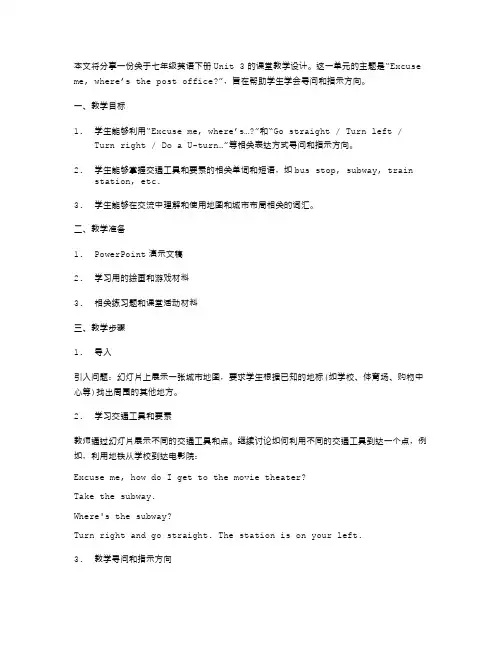
本文将分享一份关于七年级英语下册Unit 3的课堂教学设计。
这一单元的主题是“Excuse me, where’s the post office?”,旨在帮助学生学会寻问和指示方向。
一、教学目标1.学生能够利用“Excuse me, where’s…?”和“Go straight / Turn left /Turn right / Do a U-turn…”等相关表达方式寻问和指示方向。
2.学生能够掌握交通工具和要素的相关单词和短语,如bus stop, subway, trainstation, etc.3.学生能够在交流中理解和使用地图和城市布局相关的词汇。
二、教学准备1.PowerPoint演示文稿2.学习用的绘画和游戏材料3.相关练习题和课堂活动材料三、教学步骤1.导入引入问题:幻灯片上展示一张城市地图,要求学生根据已知的地标(如学校、体育场、购物中心等)找出周围的其他地方。
2.学习交通工具和要素教师通过幻灯片展示不同的交通工具和点。
继续讨论如何利用不同的交通工具到达一个点,例如,利用地铁从学校到达电影院:Excuse me, how do I get to the movie theater?Take the subway.Where's the subway?Turn right and go straight. The station is on your left.3.教学寻问和指示方向教师在幻灯片上展示不同地理位置的照片和地图,提示学生开始学习如何问路和指路。
教师向学生展示如何使用“Excuse me, where’s…?”句型,以及“Go straight / Turn left / Turn right / Do a U-turn…”等表达方式来指示方向。
教师可以与学生分组进行角色扮演,以加强他们的语言进程和提高他们的口语表达能力。
4.练习方向、地图和城市布局相关的词汇通过游戏、图片和绘画等多种形式收集和展示不同的地图和城市布局相关的单词和短语,例如:Bus stop / Subway / Train stationNorth / South / East / WestOn the left / On the right / Across the street / Next to5.面向现实场景的实践通过现实场景的练习加强学生的学习效果。
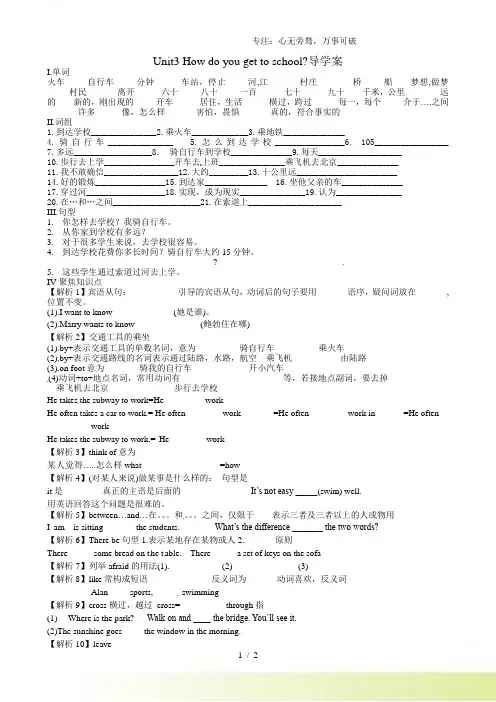
Unit3 How do you get to school?导学案I.单词火车_____自行车_____分钟______车站,停止_____河,江_______村庄________桥_____船____梦想,做梦_____村民_______离开______六十_____八十_____一百______七十______九十____千米,公里________远的____新的,刚出现的_____开车______居住,生活______横过,跨过______每一,每个_____介于….之间_______许多______像,怎么样_______害怕,畏惧_______真的,符合事实的_______II.词组1.到达学校_______________2.乘火车_____________3.乘地铁______________4.骑自行车_______________5.怎么到达学校________________6. 105_________________7.多远__________________8. 骑自行车到学校______________9.每天___________________10.步行去上学________________开车去上班_______________乘飞机去北京______________11.我不敢确信_________________12.大约_________13.十公里远_______________________14.好的锻炼________________15.到达家______________ 16.坐他父亲的车______________17.穿过河__________________18.实现,成为现实_______________19.认为_______________20.在…和…之间____________________21.在索道上_____________________III.句型1.你怎样去学校?我骑自行车。
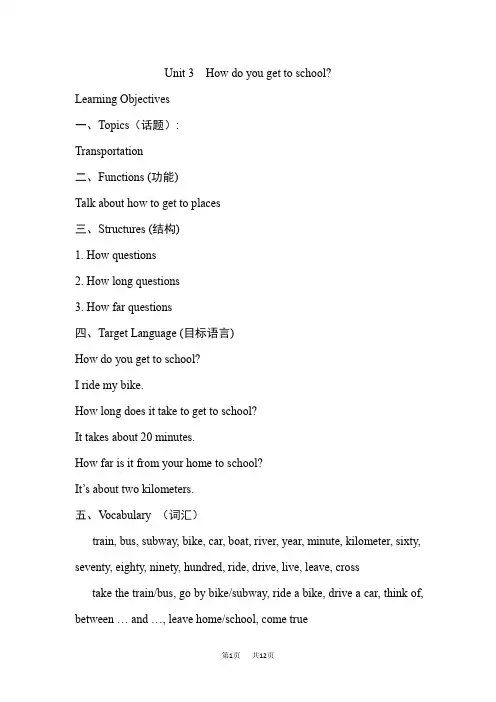
Unit 3 How do you get to school?Learning Objectives一、Topics(话题):Transportation二、Functions (功能)Talk about how to get to places三、Structures (结构)1. How questions2. How long questions3. How far questions四、Target Language (目标语言)How do you get to school?I ride my bike.How long does it take to get to school?It takes about 20 minutes.How far is it from your home to school?It’s about two kilometers.五、V ocabulary (词汇)train, bus, subway, bike, car, boat, river, year, minute, kilometer, sixty, seventy, eighty, ninety, hundred, ride, drive, live, leave, cross take the train/bus, go by bike/subway, ride a bike, drive a car, think of, between … and …, leave home/school, come true六、Skills (技能)Listening for key informationScanning in reading七、Recycling (复习巩固)Numbers 1–30I usually …It is easy to …Thanks for …八、教材分析本单元以How do you get to school?为中心话题,主要运用How long/How far 询问“去某地的交通方式、时间、距离”,简单描述路线。
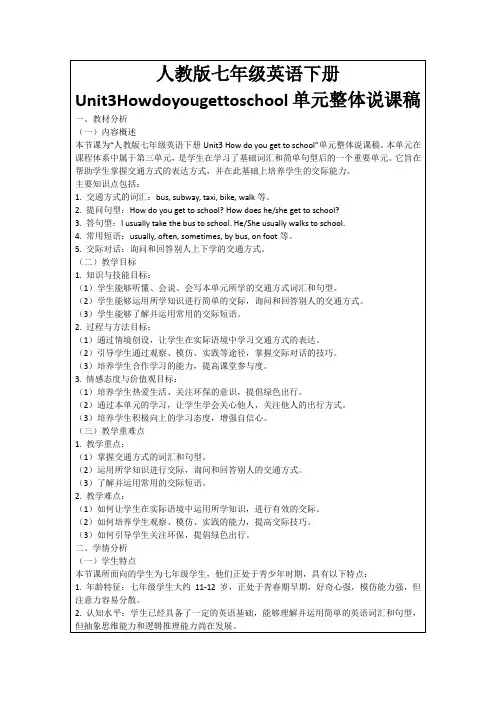
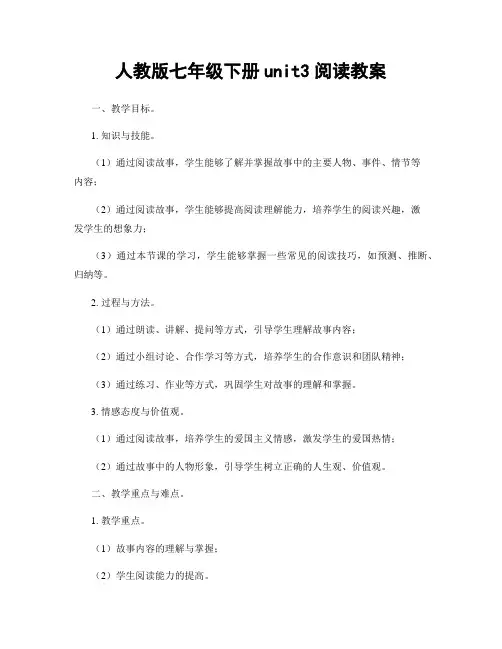
人教版七年级下册unit3阅读教案一、教学目标。
1. 知识与技能。
(1)通过阅读故事,学生能够了解并掌握故事中的主要人物、事件、情节等内容;(2)通过阅读故事,学生能够提高阅读理解能力,培养学生的阅读兴趣,激发学生的想象力;(3)通过本节课的学习,学生能够掌握一些常见的阅读技巧,如预测、推断、归纳等。
2. 过程与方法。
(1)通过朗读、讲解、提问等方式,引导学生理解故事内容;(2)通过小组讨论、合作学习等方式,培养学生的合作意识和团队精神;(3)通过练习、作业等方式,巩固学生对故事的理解和掌握。
3. 情感态度与价值观。
(1)通过阅读故事,培养学生的爱国主义情感,激发学生的爱国热情;(2)通过故事中的人物形象,引导学生树立正确的人生观、价值观。
二、教学重点与难点。
1. 教学重点。
(1)故事内容的理解与掌握;(2)学生阅读能力的提高。
2. 教学难点。
(1)培养学生的阅读兴趣;(2)引导学生进行深层次的阅读理解。
三、教学过程。
1. 导入新课。
通过谈论一些与故事有关的话题,引起学生的兴趣,如“你喜欢听故事吗?为什么?”、“你最喜欢的故事是什么?为什么?”等。
2. 阅读故事。
(1)教师朗读故事,学生跟读;(2)教师讲解故事中的生词、短语等;(3)学生分组讨论故事中的主要人物、事件、情节等内容;(4)学生展示小组讨论成果,进行互动交流。
3. 操作练习。
(1)学生个人完成故事相关的练习题,如选择题、判断题等;(2)学生交流答案,订正错误。
4. 拓展延伸。
(1)教师提出一些与故事相关的问题,引导学生进行深层次的思考和讨论;(2)学生进行小组合作,展示他们对故事的理解和想法;(3)学生进行个人总结,写下对故事的感想。
5. 作业布置。
布置阅读相关的作业,如写一篇关于故事的读后感,或者选择一段故事进行朗读等。
四、教学反思。
本节课通过故事的阅读,引发学生的阅读兴趣,培养学生的阅读能力,同时也培养了学生的合作意识和团队精神。
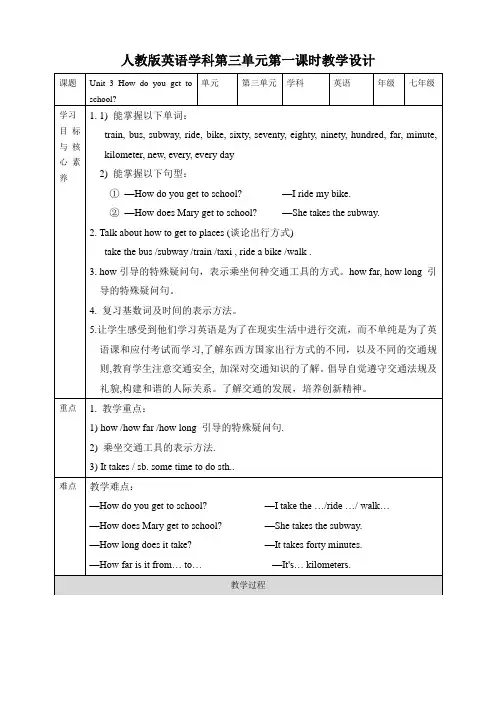
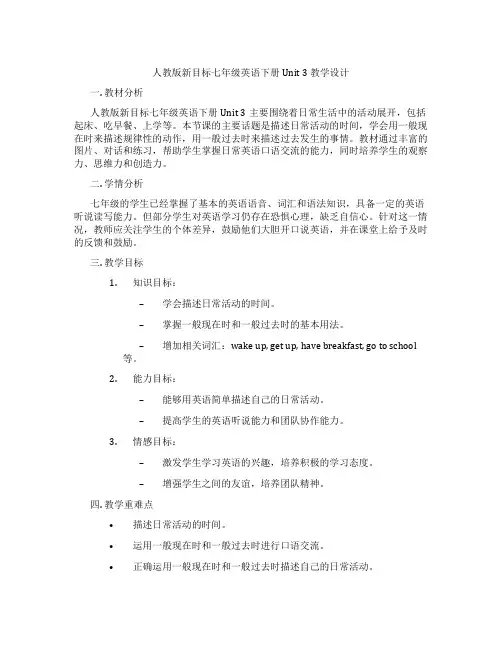
人教版新目标七年级英语下册 Unit 3 教学设计一. 教材分析人教版新目标七年级英语下册Unit 3主要围绕着日常生活中的活动展开,包括起床、吃早餐、上学等。
本节课的主要话题是描述日常活动的时间,学会用一般现在时来描述规律性的动作,用一般过去时来描述过去发生的事情。
教材通过丰富的图片、对话和练习,帮助学生掌握日常英语口语交流的能力,同时培养学生的观察力、思维力和创造力。
二. 学情分析七年级的学生已经掌握了基本的英语语音、词汇和语法知识,具备一定的英语听说读写能力。
但部分学生对英语学习仍存在恐惧心理,缺乏自信心。
针对这一情况,教师应关注学生的个体差异,鼓励他们大胆开口说英语,并在课堂上给予及时的反馈和鼓励。
三. 教学目标1.知识目标:–学会描述日常活动的时间。
–掌握一般现在时和一般过去时的基本用法。
–增加相关词汇:wake up, get up, have breakfast, go to school 等。
2.能力目标:–能够用英语简单描述自己的日常活动。
–提高学生的英语听说能力和团队协作能力。
3.情感目标:–激发学生学习英语的兴趣,培养积极的学习态度。
–增强学生之间的友谊,培养团队精神。
四. 教学重难点•描述日常活动的时间。
•运用一般现在时和一般过去时进行口语交流。
•正确运用一般现在时和一般过去时描述自己的日常活动。
•学会在适当的情境下使用一般现在时和一般过去时。
五. 教学方法1.情境教学法:通过设定生活情境,让学生在实际语境中学习、运用英语。
2.任务型教学法:引导学生参与各种小组活动,提高学生的团队协作能力和口语表达能力。
3.激励评价法:及时给予学生反馈,关注学生的点滴进步,激发学生的学习兴趣。
六. 教学准备1.教学素材:教材、多媒体课件、录音机、磁带、相关图片等。
2.教学工具:黑板、粉笔、投影仪等。
七. 教学过程1.导入(5分钟)–教师与学生用英语进行自由谈话,引导学生谈论日常活动。
–提问:What time do you get up? What do you have for breakfast? 让学生用英语回答。

Unit 3 How do you get to schoolPeriod 1教学内容与分析教学内容:Make a list ; Listen and write ; Pairkwork教学目标:1) 能够谈论:How do you get to school? 掌握各种交通工具的英语表达法。
2) 能够听、说、认读句子:A:How does Bob get to school? B:He takes the train.3) 能用熟练地运用这些句型对不同交通工具的使用进行谈论和比较。
教学重点、难点分析教学重点:能够听、说、读、写各类交通工具并在实际情景中会运用How do you get to school?句型进行交际活动。
教学难点:take ride the/ a …to + 地点= go to + 地点+ by…walk to +地点= go to + on foot教学设计Teaching proceduresStep ⅠWarming-up and Revision1.Greetings and free talk.2.RevisionStep ⅡLead in1. Listen and guess what it is.Listen and guess what it is. Revise the old words and teach the new words.2. Guessing gameThe teacher say a sentence ask the students to guess what kind of transportation it is.---It is like a bike but goes much faster. ---A motorbike.---It is like a train but goes under the ground. ---A subway.---It goes in the water. ---A ship or a boat.---It takes you about three hours to go to Beijing from Shenzhen by it. ---A plane.---It can take people to the moon. ---A spaceship.---It is very useful, you may ride it to school. ---A bike3. There are so many transportations around the world. What kind of transportation do you like to choose ?Ask how do you get to school/Shanghai/ Hangzhou/ Luqiao /Paris….?Help the students answer:I take the subway./take the bustake a minibus /take a taxitake the train / take the planetake the ship/take the carride my/a bikeride a motorbike/walkStep ⅢTo work in pairs, ask and answerAsk the students to work in pairs.A: How do you get to school?B: I walk to school. I ride a bike to school.I take a bus to school. I take a car to school.I take the subway to school. I take the train to school.Step ⅣPresentation1. First ask two students to ask and answer in pair.Then ask the other students “how does he/she get to school?”He/She takes the subway. /……rides his/her bike……walks.Step ⅤGroup workAsk the students to do group work.A: How do you get to school?B: I take the bus. / ride my bike/ bicycle./ walk.C: How does he /she get to school?He/She takes the bus/… rides his/her bike/bicyc le ./ walks.Step ⅥWork on 1a and 1b.1. To do Section A 1a look at the picture and write down the way of transportation.2. To listen to the tape and finish1b.Step ⅦPresentationAsk “h ow does Bob get to school?’ Help them answer he takes the train.Then ask “how does Paul get to school?” "He walks."Say Paul usually walks to school. He goes to school on foot.Show some pictures to students. Ask them to say like this.My father rides a bike to work every day. =My father goes to work by bike every day. Step ⅧTo work in pairs, ask and answerShow some pictures to the students then ask then to work in pairs.A: How do you get to......? B: I take/ride/walk......I get to school...by.../on...Step ⅨSummaryTake/ride the/a ...to+地点=go to +地点+by....Walk to+地点=go to +on foote.g. He often takes the subway to work.=He often goes to work by subway.注意:当home, here, there 作地点时to 不要。
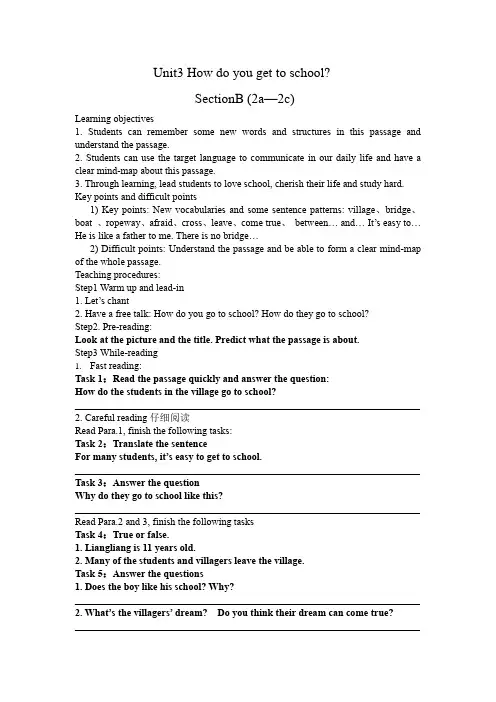
Unit3 How do you get to school?SectionB (2a—2c)Learning objectives1. Students can remember some new words and structures in this passage and understand the passage.2. Students can use the target language to communicate in our daily life and have a clear mind-map about this passage.3. Through learning, lead students to love school, cherish their life and study hard. Key points and difficult points1) Key points: New vocabularies and some sentence patterns: village、bridge、boat 、ropeway、afraid、cross、leave、come true、between… and… It’s easy to… He is like a father to me. There is no bridge…2) Difficult points: Understand the passage and be able to form a clear mind-map of the whole passage.Teaching procedures:Step1 Warm up and lead-in1. Let’s chant2. Have a free talk: How do you go to school? How do they go to school?Step2. Pre-reading:Look at the picture and the title. Predict what the passage is about.Step3 While-reading1.Fast reading:Task 1:Read the passage quickly and answer the question:How do the students in the village go to school?_____________________________________________________________________ 2. Careful reading仔细阅读Read Para.1, finish the following tasks:Task 2:Translate the sentenceFor many students, it’s easy to get to school._____________________________________________________________________ Task 3:Answer the questionWhy do they go to school like this?_____________________________________________________________________ Read Para.2 and 3, finish the following tasksTask 4:True or false.1. Liangliang is 11 years old.2. Many of the students and villagers leave the village.Task 5:Answer the questions1. Does the boy like his school? Why?_____________________________________________________________________ 2. What’s the villagers’ dream? Do you think their dream can come true?_____________________________________________________________________3.Discussion(讨论)How can their dream come true?What can we do?What can they do?Their dream can come true if(如果) people around the world(世界各地的人们)help them.By discussing the answers of the questions, it can improve their ability of cooperation.4. Read the passage again. Complete the sentences with the words from the passage.1) For the students in the village, it is ________ to get to the school.2) They have to cross a very _____ river between their school and the village.3) They cannot go by boat because the river runs too _________.4) It is not easy to cross the river on a ropeway, but the boy is not _______.5) The students and villagers want to have a bridge. Can their dream come _____? 5. ListeningListen and repeat, try to imitate the pronunciation and intonation.Step4.Post-reading:Retell the whole passage according to the mind-map.For many students-----It’s easy to get to schoola big river between…difficult no bridge so……For the students inone small village the river runs quicklyone 11-year-old boyLiangliangis is not afraidloves schoolDream------have a bridge-----come trueRewritingComplete the passage without looking at your own books.Life is precious(宝贵的). We should cherish our good life now.(珍惜现有的生活)Step7.Homework1. For all: Finish the exercise and preview 3a and 3b.2. Optional: Write a letter to the village students and tell them the way you get to school and what you want to do for them.Unit 3 How do you get to school?学情分析Section B (2a-2c)七年级下册教材内容,较七年级上册内容比,英语知识点深入,而且我们这里的学生地处比较偏远的农村地区,各种条件相对比较落后。
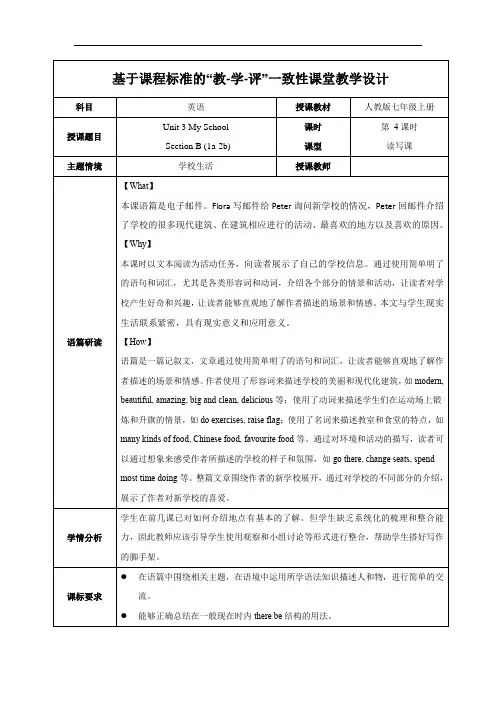

Unit 3 Will people have robots?Section B 2a-2d教学设计一、教学设计指导思想和理论依据《中学英语教学大纲》指出:“中学英语教学的目的是对中学生进行听、说、读、写的基本训练,培养学生口头上、书面上初步运用英语的能力,侧重培养阅读能力”。
阅读理解是吸收书面信息的最重要手段,它能给学生提供更为丰富的教育教学资源。
现行初中教材中,阅读课文是各单元教学的核心,容量大、密度高、话题广、课时紧。
但阅读课是培养学生阅读能力的主要渠道,在教学实践中构建合理有效的阅读课堂模式,以充分调整学生的积极性和主动性是英语教学的重点。
本节课旨在创设各种机会和条件,让学生参与语言的实践活动,不断提高他们的语言运用能力。
二、教学背景分析1、教学内容分析本节课是一篇阅读课。
围绕机器人发展之路展开话题,内容主要涉及机器人的现在和未来,其中还穿插了科学家的不同观点。
篇幅较长,旨在训练发展学生的阅读能力。
同时通过对机器人现在与未来的讨论,激发、培养学生对未来生活的向往,鼓励学生为实现美好的梦想更加努力地学习。
2、学情分析优势:通过学习,学生能听懂基本的课堂指示语,经过不断的训练,学生能有效地展开课堂活动。
本节课的内容涉及机器人,学生会有很浓厚的兴趣,会对教学产生良好的影响。
困难:班级学生整体水平差异很大,部分学生词汇量不足,阅读习惯不好,导致阅读速度慢,阅读理解能力差,对整体教学带来一定困难。
因此在组织教学活动中,要注重学习策略的指导,灌输自主、合作、探究学习的思路,同时注意调整活动任务设置的梯度,使每个学生通过学习活动,都能学有所成,体验到成功。
3、教学方式、教学手段、技术设备说明本节课设计利用思维导图的形式从robots today, robots in the future两个方面梳理文章脉络,并指导学生用思维导图来复述文章,锻炼学生的归纳总结和语言表达能力。
运用“讨论-限时自读-导读-复读-讨论”的基本课堂教学模式,设计学生学习活动。
教学设计课题:基于未来课程的PBL教学模式之Transportation --人教版七下Unit 3课型: PBL教学模式年级:七年级授课人:庄秋蚕(东莞市清溪中学)一.背景分析人教版新目标英语七年级下册第三单元主要围绕出行与交通方式的相关知识展开,本单元要求学生学习乘坐不同的交通工具的表达以及到达目的地所需要的时间,并在此基础上学会询问距离。
本节课有意识的渗透乘坐交通工具去旅行,为进一步扩拓展挖深教案内容,整合课程资料,培养学生的创造性思维,为完成任务单埋下伏笔。
(一)主题语境该节课面向七年级学生。
课题为:基于未来课程的PBL教学模式之Transportation。
课堂主要任务背景以通过了解“Lu Yue”这个学生为切入点,通过对图片的介绍和讨论等活动,为完成任务单做铺垫,最终以口头表达的形式进行产出。
(二)语篇类型:PBL教学模式(三)授时课长:45分钟二.学情分析本次授课对象是七年级的学生,对英语比较感兴趣。
一部分学生学习英语兴趣浓厚,他们思维活跃、表现积极,口头表达能力强,但是有部分学生学习英语存在困难,对于英语学习的自信心不足,回答问题腼腆,羞于表达。
这也正是七年级学生学习英语表现出来的特性。
对于本节课教材内容而言,出行与交通是学生熟悉和喜爱的话题。
本节课的重点和难点是如何在此基础上,引导学生对不同交通方式的提出看法和观点,因此笔者运用PBL教学策略,由浅入深,由易到难,层层递进,突出重点,突破难点,降低学生填写任务单时语言输出的难度。
如何撰写任务单并将分享任务单是本课时的一项延伸内容也是本节课的重点和难度。
三.教学目标语言能力:1. 通过同伴讨论、小组合作拓展思维、积累词汇和表达等素材;2. 利用积累的素材,填写任务单并且进行任务分享。
思维品质:通过多样化的活动进行思维延伸,让学生懂得从不同的角度看待问题、解决问题,并结合自身情况,做好合理的计划。
通过讨论,分析不同的交通方式的利弊,培养学生的思辨能力。
七下Unit 3 Section B(2a-2c)ReadingCrossing the river to school教案一.教材分析本单元是人教版《Go for it 》七年级下册第三单元。
单元话题是“Transportation”。
通过单元学习,让学生学会“Talk about how to get to places”,理解并掌握“How long does it take? How do you get to school? How far is it? It takes sb. some time to do sth. It is adj. to do sth.”等句型的提问和回答。
让学生能谈论日常上学的经历,并且学会正确使用交通工具和数字1-30的英文表达。
同时培养学生的交通安全意识。
本课Section B (2a-2c) 是本单元的第四课时,是读写课。
目标是培养学生良好的阅读习惯,提高他们的阅读能力,增强他们对文章结构的整体感知能力,为接下来的写作教学奠定基础。
本课时的阅读材料讲述的是边远山区的孩子乘索道过河上学的感人故事,这个故事能吸引学生注意力和激发他们刻苦学习的动力。
二.教学设计理念《新课程标准》指出:语言学习要从语法讲解中和单词的死记硬背中解脱出来,要通过创设良好的语言环境和提供大量的语言实践机会,使学生通过自己的体验、感知、实践、参与和交流,形成语感;在教师的引导下,通过观察、发现和归纳等方式,掌握语言的规律,形成有效的学习策略,发展交流与合作的能力。
《英语新课程标准》明确规定:初中英语教学要侧重培养学生的阅读能力。
英语阅读教学的主要目的是教给学生正确的阅读方法、阅读技巧、培养学生的阅读能力,为继续学习英语和运用英语切实打好基础。
本节课以学生为主体,以课标为准绳,以多媒体为手段,以兴趣为中心,以合作为纽带,为学生创造一个轻松愉悦、积极向上的英语学习氛围,力争为每个学生都提供适合自己的学习和练习机会。
人教版新目标英语七年级下册《Unit 3 How do you get to school》获奖教学设计一. 教材分析《Unit 3 How do you get to school》是人教版新目标英语七年级下册的一单元,主要讨论人们如何去学校。
本单元涉及到了各种交通工具,以及询问和描述交通方式的语言表达。
教材通过丰富的情景和任务型活动,帮助学生巩固和提高日常英语交际能力。
二. 学情分析七年级的学生已经掌握了基本的英语语法和词汇,具备一定的听、说、读、写能力。
他们在生活中也经常会用到与本单元相关的一些词汇和句子,如“How do you get to school?”“I go to school by bus.”等。
但部分学生对一些交通方式和人称代词的运用还不够熟练,需要在教学中加强操练。
三. 教学目标1.能听懂、会说、会读本单元的生词和重点句子。
2.能运用所学知识描述自己和他人的交通方式。
3.提高学生的团队协作能力和日常英语交际能力。
四. 教学重难点1.交通方式的表达。
2.人称代词的运用。
3.询问和描述交通方式的句子结构。
五. 教学方法采用任务型教学法,通过丰富的情景和活动,引导学生主动参与课堂,提高他们的听、说、读、写能力。
同时,运用分组合作、角色扮演等方法,培养学生的团队协作能力和交际能力。
六. 教学准备1.准备本单元的生词和句子卡片。
2.制作多媒体课件,包括图片、视频等资源。
3.准备交通工具的模型或图片。
4.准备录音机或音响设备。
七. 教学过程1.导入(5分钟)通过播放一首关于交通工具的歌曲,引导学生谈论他们喜欢的交通工具。
同时,老师出示一些交通工具的图片,帮助学生复习已学的词汇。
2.呈现(10分钟)老师出示一张学校的图片,询问学生如何去学校。
引导学生用英语表达自己的交通方式,如“I go to school by bus.”。
同时,介绍本节课的重点句子和词汇。
3.操练(10分钟)学生分组,每组选择一种交通工具,用英语讨论如何去学校。
教师学科教案[ 20 – 20 学年度第__学期]任教学科:_____________任教年级:_____________任教老师:_____________xx市实验学校英语七年级下人教版新课标Unit 3 How do you get to school Section A 1a-1c教学设计熨斗中学阮班玉一、概述本单元以“交通工具”为中心话题,围绕谈论“How do you get to school?”而展开教学及运用How long/How far 询问去某地的时间和距离,而Section A (1a-1主要是学习交通工具的单词和运用how引导的特殊疑问句,询问到达目的地的,这一话题贴近学生们的日常生活,它继第三单元谈论“假日计划”后安排这样一个话题,符合学生的认知结构和年龄特征,它将为本单元后面的课时做好铺垫,也为学生口语交际打下基础。
本课是本单元的第一课时。
本单元认识掌握交通工具,然后学习短语take the subway, take the train, ride a bike, walk等,最后学习句型How do you get to school? I take the bus. 在本节课中学生要学习练习含有第一,二人称和第三人称单数,How 引导的特殊疑问句。
How doe Mary get to school? She takes the subway.二、教学目标分析:1. 知识与技能:1) 能掌握以下单词:bus, train, subway, taxi, walk, pane, ride, bike.2) 能掌握以下短语:take the bus, take the subway, take the train, take the taxi, take the plane, take the car,drive the car, ride the bike, walk.3) 能掌握以下句型:①—How do you get to school?ride my biketake the busI take the subway to school.take the taxitake the carwalk②—How does Mary get to school?rides my biketakes the busShe takes the subway to school.takes the taxitakes the carwalks4)学会将课内外习得的生词和习惯用语、谈论交通工具等综合运用。
Unit 3 How do you get to school?Learning Objectives一、Topics(话题):Transportation二、Functions (功能)Talk about how to get to places三、Structures (结构)1. How questions2. How long questions3. How far questions四、Target Language (目标语言)How do you get to school?I ride my bike.How long does it take to get to school?It takes about 20 minutes.How far is it from your home to school?It’s about two kilometers.五、V ocabulary (词汇)train, bus, subway, bike, car, boat, river, year, minute, kilometer, sixty, seventy, eighty, ninety, hundred, ride, drive, live, leave, cross take the train/bus, go by bike/subway, ride a bike, drive a car, think of, between … and …, leave home/school, come true六、Skills (技能)Listening for key informationScanning in reading七、Recycling (复习巩固)Numbers 1–30I usually …It is easy to …Thanks for …八、教材分析本单元以How do you get to school?为中心话题,主要运用How long/How far 询问“去某地的交通方式、时间、距离”,简单描述路线。
本课时为本单元的第二课时,是一节听说练习与写作相结合的课型,我将采用大量操练使学生掌握How far 和how long 的句型以及学会运用简单的语言对自己上学的路线、方式进行描述。
根据《英语课程标准》关于总目标的具体描述及《新目标英语》教材的语言教育理念,我将教材内容进行整合,如为了让学生更好的理解3a课文我将书上的三个预设问题分解为听文章回答简单问题,理解问题,以及细节问题三个层次,层层递进。
九、教学目标(一)知识技能1)能够掌握how,how far, how long 句型,并用其询问他人上学方式及时间、路程。
2)能运用简单的语言对自己上学的路线、方式进行描述;3)阅读3a上的文章,能理解大意,回答相应问题,并复述大意。
能运用语言简单描述他人出行的路线。
(二)过程与方法运用功能交际法,游戏法,利用多媒体创设情境情,等多种教学方法。
同时通过在英语朗读,完成任务的过程中让学生进行有效的自我调控,提升语言交际能力。
(三)情感态度对比班级学生上学方式与山村孩子的艰辛上学路,让学生珍惜现在,努力学习。
十、教学重难点:how,how far,how long 句型的综合运用以及单三的使用。
解决措施: 运用功能交际法,情境教学法,以及对比提问法进行大量操练。
十一、课时安排第一课时:完成Section A 1a–2d第二课时:完成Section A 2e–3c第三课时:完成Section B 1a–1e第四课时:完成Section B 2a–Self CheckThe First Period (Section A, 1a–2c)Teaching aims (教学目标)1. 学习表示交通工具的单词。
2. 学会使用动词短语表示交通方式。
3. 能够熟练掌握How do you get to school?的句型。
4. 学习使用how far询问距离,how long 询问时间。
Language points (语言点)1. 词汇:1)名词n. train, bus, subway, ride, minute, kilometer2) 动词v. ride3) 数词num. sixty, seventy, eighty, ninety, hundred4) 形容词和副词adj. & adv. far5) 词组take the subway, ride a bike2. 句型:How do you get to school? I …How long does it take …? It takes …How far is it from … to …? It’s about …Difficulties (教学难点)1. 交通工具的表达法。
2. How,how far,how long 句型的使用及区别。
Teaching steps (教学步骤)1. Warm-up and revision(课堂热身和复习)(1)Greet the class. (Talk about the weather. Use the present and past tense. )T: How’s the weather today?S: It is …T:How was the weather yesterday?S: It was …(2) Play a guessing game.T: Look at the sentences and pictures and guess the kinds of transportation.【教学设计说明】通过多媒体屏幕向学生展示所学单词,图文并茂,非常直观地向学生展示了新单词.简单的单词游戏既调动了学生的学习积极性又强化了单词记忆。
2. Presentation (呈现新知识)(1) Present the new words: take a train, take the bus, take the subway, ridea bike, walkShow some pictures of the new words on the screen. Ask Ss to try to read these words.T: Let’s play a word game. (Ask Ss to look through the new words quickly, and check how many they can reme mber. Give Ss some pictures of the new words and some word cards. Then show the new words or the pictures of the new words on the screen. For example, when you show the word “train” on the screen, the student who has the picture of a train should stand up quickly and say “I’m here!”)【教学设计说明】图片教学法是呈现新知识最简单有效的方法之一,学生通过图片,能更价值观的理解新单词的含义。
此环节重点在新单词及词组的意思和发音上,所以要尽量让更多的学生张口说,必要的机械操练是必不可少的。
3. Drill (练习)Show the pictures as quickly as possible. Let Ss say the new words. Then use the new words to make conversations.T: Let’s play a game. Please say the new words as quickly as you can. Then make a conversation like this:A: How do you get to school?B: I take a bus to school.【教学设计说明】此环节为机械操练,使不同层次学生初步掌握目标语言。
机械操练是英语初始阶段教学必不可缺的部分,学生要先从模仿到初步掌握,最后才能熟练应用。
机械操练时应注意着重提问成绩较差的学生,由于机械操练比较简单,因此是激发后进生兴趣,培养后进生自信的一个很好的途径。
4. Work on 1a (完成1a)(1) Match the words with the pictures.(2) Talk about the picture with Ss using the target language.T: How does “a” get to school?【教学设计说明】通过1a的练习,使学生进一步学会运用新单词。
和学生一起谈论图片,目的在于引导学生学会使用交通工具的表达法。
5. Work on 1b (完成1b)(1)Listen and write the numbers next to the correct Ss in the picture.(2) Look at the picture in 1a. How do the Ss g et to school?Make conversations with your partner.A: How does Mary get to school?B: She takes the subway.【教学设计说明】此环节着重是听力训练。
让学生在听对话的过程中抓住关键词汇,由于前面已做了一些训练,因此学生听起来比较容易,让他们都有一次成功的喜悦和感受,这样可以增强他们的学习自信心。
6. Work on 2a–2c (完成2a, 2b和2c)(1)T: Please turn to page 14. Look at the numbers in 2a. Read them aloud.(2)T: Now let’s listen carefully and complete the chart.(3)T: Can you get the answers? Listen again and check your answers.(4)T: How does Tom get to school?How long?How far?【教学设计说明】此环节进一步巩固了本堂课所学的词汇和句型。
通过反复听读,可以让学生尽快熟悉生词。